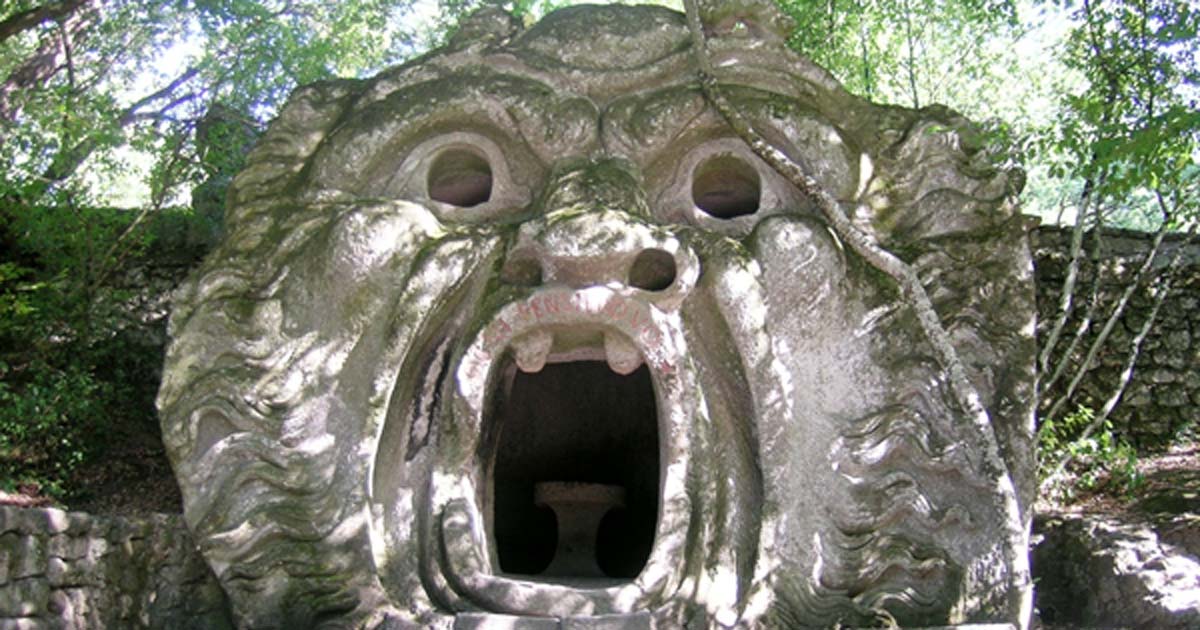Where the Wild Things Are: Garden of Monsters Was Built to Convey the Despair of its Creator
Located in the Garden of Bomarzo, in Northern Lazio, Italy is The Sacro Bosco, or “Sacred Grove,” also known as the Park of Monsters, or the Villa of Wonders. The park was commissioned in 1552 by Prince Pier Francesco Orsini, an Italian condottiero that was taken prisoner at the end of the French-Spanish Wars in Italy. The park was never meant to be beautiful but rather to shock and awe, as well as convey the despair he felt upon arriving home from war and discovering his wife had died.
Once Prince Orsini had been freed as a prisoner, he had retired to Bomarzo where he surrounded himself with painters, writers, and other artists. It was at this time that he chose Pirro Ligorio to begin construction of the park, starting in 1547. Pirro Ligorio was a widely-respected architect and artist of the time – having built Villa d’Este in Tivoli and completed the Cathedral of St. Peter in Rome after the death of Michelangelo – but this was to be an unusual and interesting job for him.

The park’s constructions reflect the despair felt by its architect after the death of his wife (CC by SA 3.0)
A unique style for the 16 th century
Although it was built during the Italian Renaissance, the garden layout bears little resemblance to the symmetry and order of other contemporary gardens. The art is made in a rough “mannerist” style, a sort of 16 th century version of surrealism. Mannerism became the antithesis of Renaissance style, where High Renaissance art emphasized proportion, balance, and ideal beauty, Mannerism exaggerated these same qualities often resulting in compositions that were asymmetrical or unnaturally elegant. The Mannerism style is also notable for its intellectual sophistication, compositional tension and instability, rather than the balance and clarity of the Renaissance style. From this, it is clear that the Mannerist style was favoured in order to shock the viewer and invoke the grief that Prince Orsini felt.

The style of the garden of monsters was quite unique for its time (CC by SA 3.0)
A dreamlike landscape
While Ligorio was the architect of the park, the sculptures are attributed to Simone Moschino. Many monstrous statues fill the park and seem to be completely disconnected from a rational plan, and they appear to have been strewn randomly around. Many of the statues once had Italian inscriptions by Annibal Caro, Bitussi, and Cristoforo Madruzzo. However, many of them seem to be eroded beyond recognition. The reason for the layout and scattered design of the park is largely unknown; Liane Lefaivre thinks they are illustrations of the romance novel Hypertomachia Poliphili, or The Dream of Poliphilus. This book is said to have been written by Italian author Francesco Colonna in 1499 and it tells the story of Poliphilo pursuing his love through a dreamlike landscape until he finally reconciles with her by the Fountain of Aphrodite. Since the park has Roman and Greek mythological ties and Orsini was a patron of the arts, this hypothesis could be likely. Another theory is that they were meant as a foil to the perfect symmetry and layout of the great Renaissance gardens nearby at Villa Farnese, and Villa Lante.

One of the sculptures in the garden of monsters (Pietro Izzo / flickr)
The bizarre sculptures in the garden of monsters
Many of the sculptures harken back to Greek and Roman mythology; some of these sculptures include: Pegasus, two sirens (one of which is possibly Proserpina), Cerberus, and the Fountain of Aphrodite. However, these are just a few in the 24 documented statues across the garden. Amongst the statues are two monuments. The first is The Leaning House, dedicated to the cardinal Cristoforo Maduzzo, who was a friend of Vicino Orsini and his wife as well as an Italian Roman Catholic cardinal and a liberal patron of the arts. The second is The Temple of Eternity, a memorial located at the top of the garden. It is an octagonal building with a mixture of classical, Renaissance, and Etruscan influences.

Many of the sculptures harken back to Greek and Roman mythology, like this statue of Neptune (Tybo / flickr)
In the early 20 th century, Spanish painter Salvador Dalí visited the park and loved it. He enjoyed his time in the park so much that he made a short film there, and the sculptures inspired his 1946 painting The Temptation of Saint Anthony. Jean Cocteau was also a fan of the park amongst other artists who produced a novel, libretto, and an opera all based on the park. In the 19 th century, and even further into the 20 th century, the garden became overgrown and neglected. However, in 1954 the park was bought by a Mr. Giovanni Bettini. Since then the Bettini family has implemented a restoration program based on the short movie and painting by Salvador Dalí. This restoration program continued through the 1970s, and today the gardens remain private property, but are open to the public as a popular tourist attraction. The Temple of Eternity currently entombs Giovanni Bettini and his wife, Tina Severi Bettini.
Top image: Ogre in the park of monsters, close to Bomarzo (CC by SA 3.0)
Resources
Atlas Obscura, 2017. The Monsters of Bomarzo. [Online] Available at: http://www.atlasobscura.com/places/the-monsters-of-bomarzo
Bomarzo, 2001. The Park of Monsters. [Online] Available at: http://www.atlasobscura.com/places/the-monsters-of-bomarzo
Fabretti, Danila., 2015. The Sacred Wood of Bomarzo. [Online] Available at: http://www.discoveringtuscia.it/en/sacro-bosco-di-bomarzo/

















